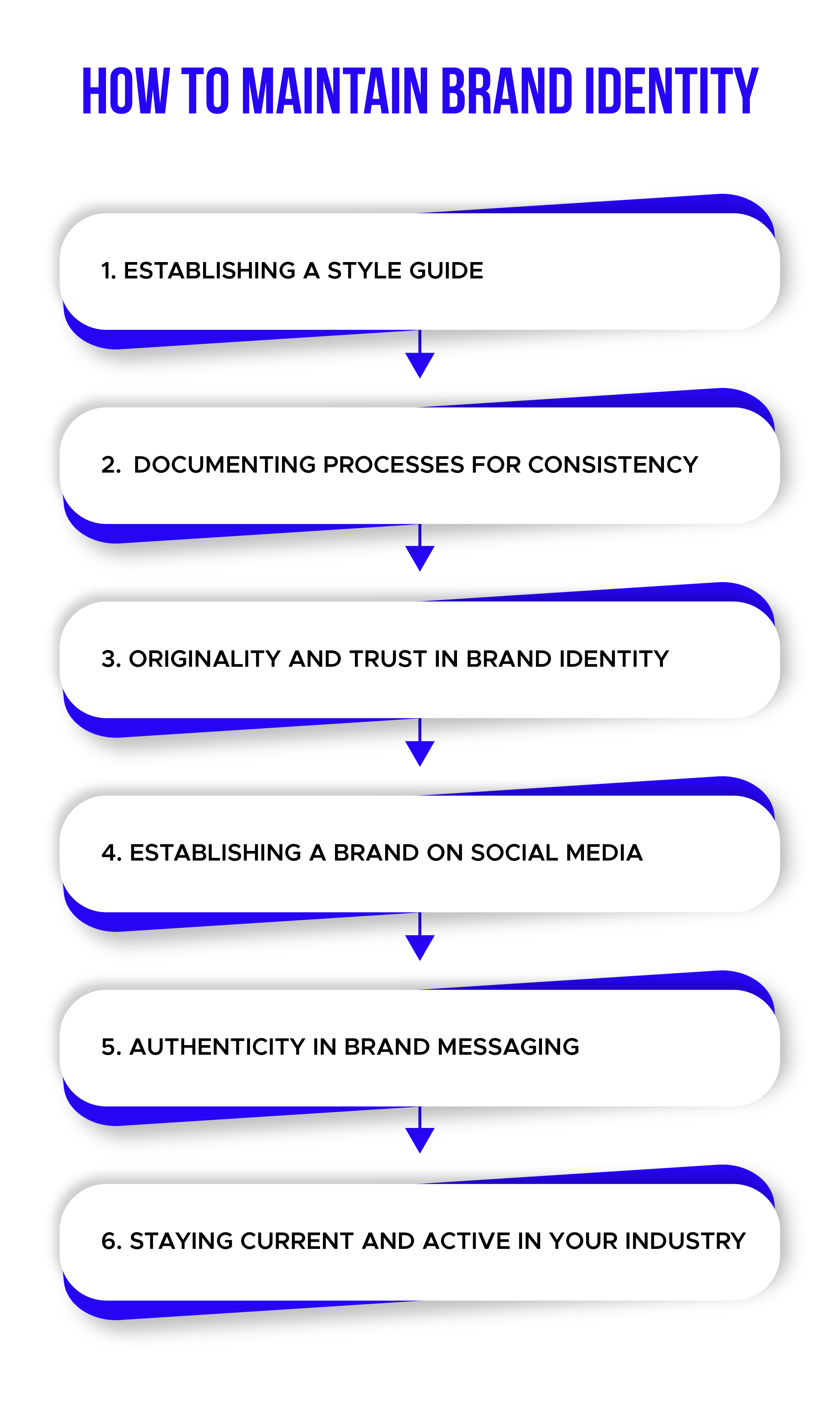Why Your Business Needs to Maintain Brand Identity
How to Maintain Brand Identity
In 2024 digital world became faster, and countless brands vie for attention, maintaining a strong brand identity has never been more crucial.
It’s the heartbeat of your business, resonating through every interaction, be it a customer’s first glance at your website or their hundredth purchase.
For business owners, cultivating and preserving a distinct brand identity isn’t just about visual aesthetics or catchy taglines; it’s about weaving a compelling story, one that resonates deeply with your audience and stands the test of time.
In this comprehensive guide, we delve into the art and science of maintaining your brand’s identity. We understand that your brand is more than just a logo or a color scheme – it’s a promise, a set of values, and a unique voice that sets you apart in a crowded marketplace.
This article is your roadmap to maintaining a brand identity that’s not only memorable but also authentically yours.
Why Your Business Needs to Maintain Brand Identity
Establishing a strong and recognizable brand identity is crucial. It’s not just about a memorable logo or a catchy slogan; it’s about creating a unique presence in the market that resonates with customers and stands out from the competition. For business owners, understanding the importance of maintaining brand identity is fundamental to long-term success.
1. Building Trust and Recognition
Customers are drawn to brands that they recognize and trust. A consistent brand identity across all platforms and touchpoints is pivotal in building this trust.
This aspect of brand management is especially crucial when considering the preferences of newer generations. According to Edelman’s Trust Barometer, Generation Z, in particular, exhibits the highest need for brand trust. An astounding 79% of this demographic assert that trusting the brands they purchase from is more important today than it was in the past.
This shift underscores a broader trend: the growing emphasis on authenticity and trustworthiness in consumer-brand relationships.
2. Differentiating from Competitors
In a crowded market, a distinctive brand identity helps to set your business apart. It’s not just about being different; it’s about being better and more relatable to your target audience.
A well-maintained brand identity conveys to your customers that you are committed to your business values and goals, which helps in creating a unique market position.
3. Enhancing Business Growth
Maintaining a strong brand identity is instrumental in business growth. It aids in attracting new customers while retaining existing ones.
A consistent and appealing brand identity can help in expanding market reach and can even justify a premium pricing strategy. Essentially, it’s a key driver for business development and expansion.
4. Encouraging Customer Loyalty
A strong brand identity fosters customer loyalty. Customers who resonate with your brand’s identity are more likely to continue choosing your products or services over competitors. This loyalty not only ensures repeat business but also creates brand ambassadors who will share their positive experiences with others, effectively contributing to your marketing efforts.
5. Supporting Marketing Efforts
Your brand identity serves as a foundation for all your marketing and advertising strategies. It provides a clear direction for how to represent your brand in various campaigns.
Consistency in brand identity across all marketing channels increases the effectiveness of these efforts, ensuring a cohesive and powerful message is delivered.
How to Maintain Brand Identity

A strong brand identity is crucial for the success and recognition of any business. It encompasses more than just a logo or a visual aspect; it’s about the perception of your business in the minds of your customers and competitors. Here are key steps to maintain and enhance your brand identity.
1. Establishing a Style Guide
One of the most fundamental steps in maintaining your brand identity is to establish a comprehensive style guide. This guide serves as the rule book for your brand’s visual and communicative aspects, ensuring consistency across all platforms. For detailed examples and inspiration, consider exploring Neu Entity’s Branding Guide Examples.
Documenting Fonts, Colors, and Logo Usage
Fonts

Choose fonts that reflect your brand’s character. Document their usage for different purposes, like headings, body text, and calls to action. Consistency in font style and size across various mediums plays a significant role in reinforcing your brand identity.
Colors

Your color palette should align with your brand’s personality. Clearly outline primary and secondary colors and their correct usage. The colors chosen should be consistent across all marketing materials to create a cohesive brand image.
Logo

Your logo is a critical component of your brand identity. Provide guidelines on its usage, including size, placement, and variations. A well-defined logo usage guide ensures that your logo is displayed correctly and consistently in various contexts.
2. Documenting processes for consistency
Maintaining brand identity is not just a matter of creating a style guide; it’s about ensuring every team member understands and consistently represents this identity.
Documenting processes for consistency is crucial. It involves creating a clear and accessible framework for all team members, aligning team efforts with the brand’s voice and tone, and facilitating the training and onboarding of new members.
For example, consider a technology company that recently rebranded to focus on sustainable products. They developed a comprehensive brand style guide, detailing new logo usage, color palette, typography, and imagery, and implemented an internal communication strategy to educate every employee about the brand’s new direction.
The importance of such documentation is highlighted when different departments create materials like marketing collateral and presentations.
Without a documented process, each department might interpret the brand guidelines differently, leading to inconsistencies. By implementing a centralized document detailing the brand guidelines, providing regular training sessions, and conducting audits for compliance, the company ensured a cohesive brand image.
3. Originality and Trust in Brand Identity
In the quest to maintain a robust brand identity, the twin pillars of originality and trust play a pivotal role. It’s not just about creating unique content; it’s about embedding honesty and innovation into the very fabric of your brand.
Innovative marketing and communication strategies are at the heart of originality. It’s about setting trends, not just following them. This innovation can be driven by encouraging creativity within your team, urging them to come up with original ideas that align seamlessly with your brand’s identity.
When your team feels empowered to think outside the box, they contribute to a brand narrative that’s fresh and engaging.
But originality must be balanced with trust. Trust is built through honesty and transparency in all your dealings – be it with customers, partners, or employees.
This means maintaining a transparent approach about your products and services and being consistent in your messaging across various platforms. It involves admitting to mistakes and addressing them openly, which in turn, reinforces the integrity of your brand.
For instance, consider the impact of storytelling in brand communication. Sharing your brand’s journey, its challenges, and successes in an honest and relatable manner can significantly deepen the bond with your audience.
Authentic engagement through social media or community initiatives further cements this relationship, providing insights into what your audience values and paving the way for more original content creation.
4. Establishing a Brand on Social Media
Establishing and maintaining a brand on social media is an essential strategy in today’s digital world. It’s about more than just having a presence; it’s about crafting a consistent, engaging identity that resonates with your audience on these platforms.
a.Pre-defined Strategy for Social Media Presence
Developing a comprehensive strategy is key. This involves deciding on the tone of your posts, the kind of content you will share, and how you will engage with your audience. It’s about understanding which platforms are most suited to your brand and how you can leverage each platform’s unique features to reinforce your brand identity.
b. Utilizing Logos and Consistent Imagery:
Your logo is often the first point of interaction with your audience. Using it strategically on your social media profiles and in your posts helps in building recognition. It’s important to ensure that your logo is displayed correctly and consistently across all platforms.
A consistent visual theme on your social media channels is crucial. This includes using a consistent color palette, typefaces, and visual style in your posts. Consistent imagery helps in creating a cohesive look that becomes synonymous with your brand.
c. Content Consistency:
Ensure that the content you post aligns with your brand’s messaging and values. Whether it’s images, videos, or text, every piece of content should reflect your brand’s personality.
Regularly updating your social media channels with fresh, relevant content keeps your audience engaged and helps maintain a strong presence.
5. Authenticity in Brand Messaging
Authenticity in messaging stands as a cornerstone. It’s about ensuring that every communication, every interaction, echoes the brand’s core values and connects genuinely with the audience.
This isn’t just a strategy; it’s a commitment to honesty and consistency that cements trust and fosters a deeper relationship with the audience.
The essence of a brand’s message should be a true reflection of its foundational values. Whether through an advertising campaign, a social media post, or a customer service interaction, the message must align with what the brand stands for.
This alignment is not just about the content of the message but also its tone, style, and delivery. Consistency across these elements is crucial in reinforcing the brand’s identity and establishing trust with the audience.
Moreover, consistency in messaging across all channels is key. Whether a customer is reading an email, browsing the website, or engaging on social media, they should immediately recognize and relate to the brand’s unique voice and style.
This recognition is vital, as it helps in building a consistent brand image, making the brand instantly identifiable and differentiating it from competitors.
6. Staying Current and Active in Your Industry
Staying current and active is a crucial strategy for keeping your brand relevant and at the forefront of your industry. In a world where digital presence significantly impacts brand perception, a proactive approach to content and engagement is vital.
a. Regular Content Updates:
Updating your website, blog, and social media platforms with fresh, relevant content is key to keeping your audience engaged and informed.
This involves more than just promotional material; it includes sharing industry insights, news, and thought leadership articles that reflect your brand’s expertise and relevance in your field. Regular updates not only attract new visitors but also encourage repeat visits, keeping your brand top-of-mind.
b. Social Media Engagement:
Active engagement on social media platforms is more than just posting regularly. It involves interacting with your audience, responding to comments, and participating in conversations.
This two-way communication fosters a community around your brand, making your audience feel heard and connected. Engagement also includes monitoring social media trends and participating in relevant discussions, further amplifying your brand’s presence and relevance.
c. Adapting to Industry Changes:
Keeping abreast of industry trends and adapting your content strategy accordingly is essential.
This might mean leveraging new social media features, exploring different content formats like videos or podcasts, or addressing emerging topics in your industry. Adaptability shows that your brand is not just current but also forward-thinking.
Conclusion
Maintaining a strong brand identity is crucial for any business. It involves establishing a detailed style guide and ensuring team alignment with brand messaging. Emphasizing originality, trust, and adaptability in your branding strategies is essential.
Regularly updating content and engaging actively on social media further solidifies your brand’s presence. Consistency in messaging across all channels reinforces brand identity and builds customer trust.
To navigate these complexities and craft a compelling brand story, partnering with a Branding Agency can provide the expertise and guidance needed to keep your brand resonant and relevant in a dynamic market.
Let’s Talk!
If what you see here is relevant for you and can help you grow your business or organisation, we’d love to discuss further with you. Drop us a message or schedule an appointment with us.

0 Comments